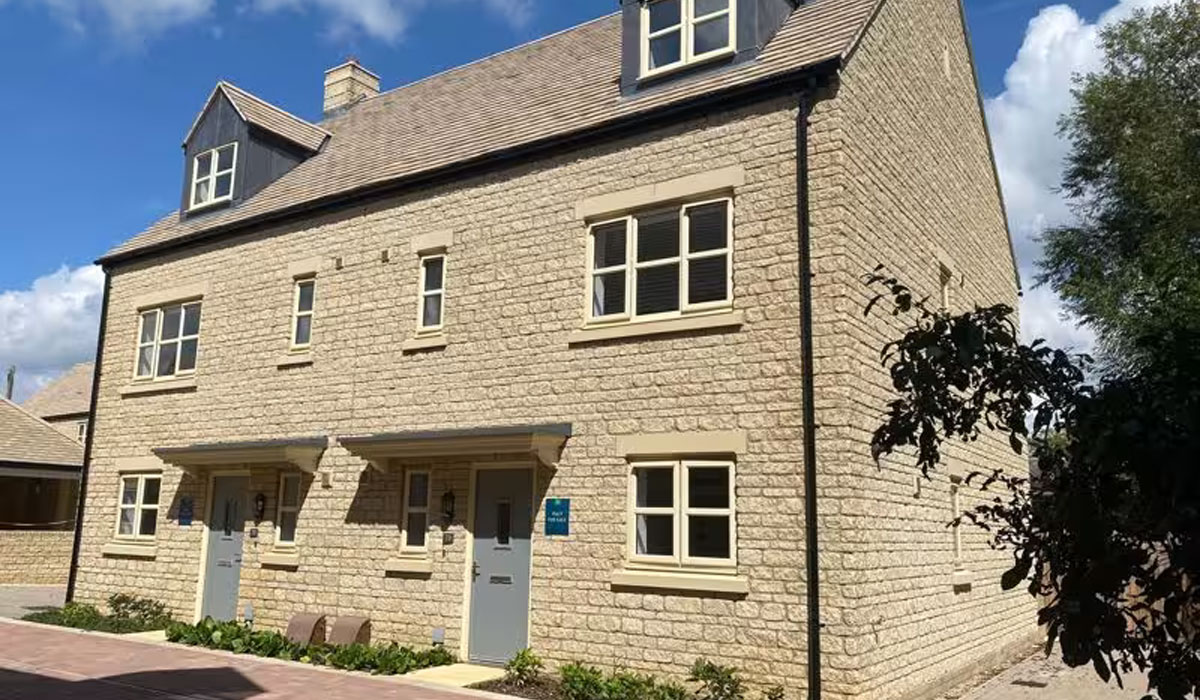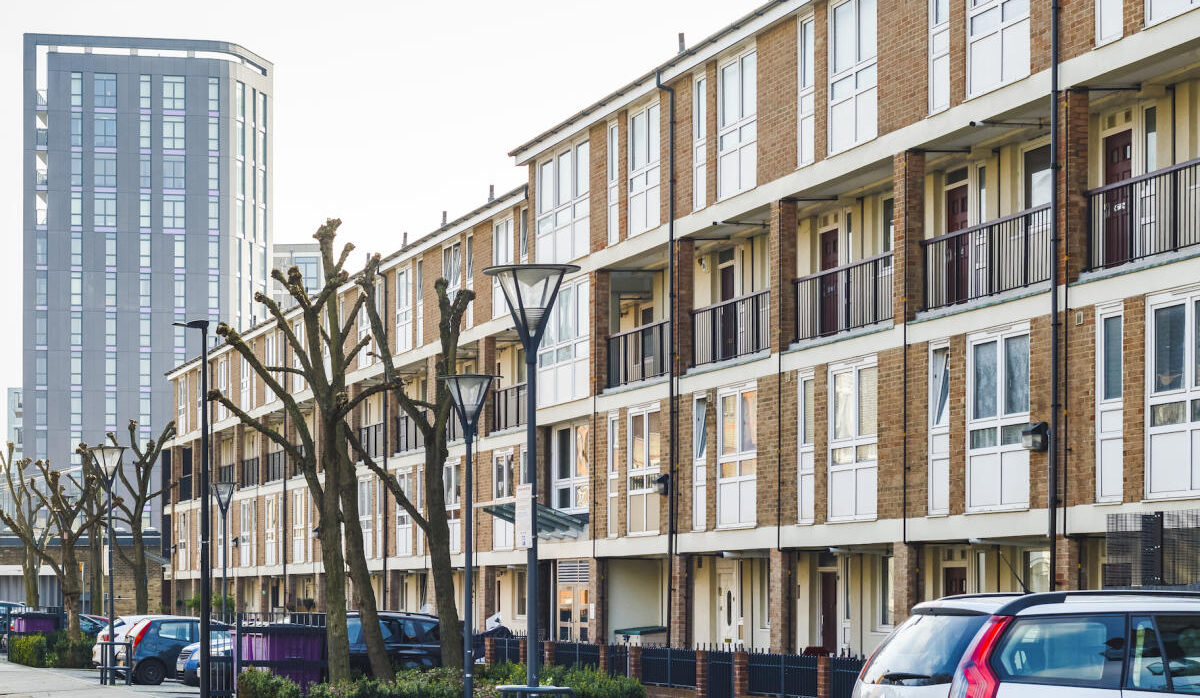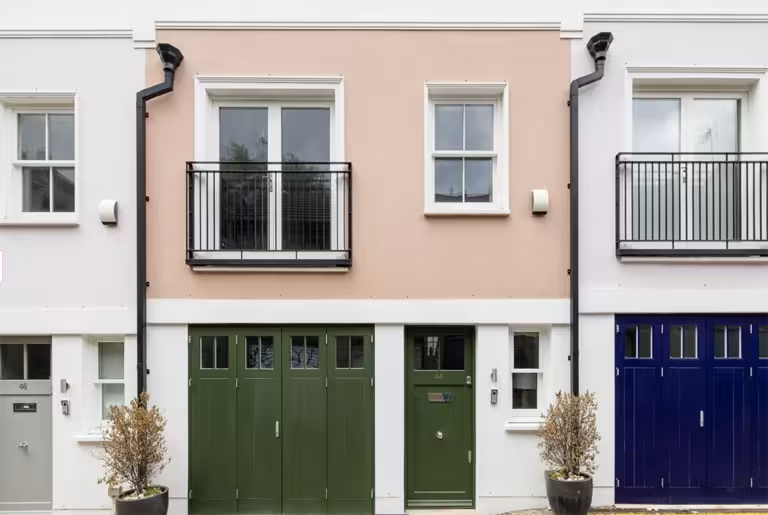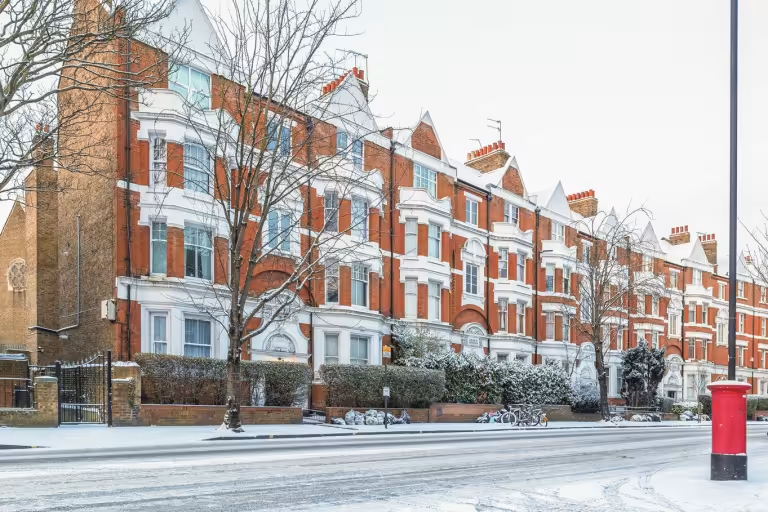Will house prices rise in 2024?
If you’re planning to buy or sell a home in 2024, what should you do? Our Executive Director of Research, Richard Donnell, shares his UK house prices forecast.
The first weeks of January have been full of reports about improving conditions in the housing sales market. Some are now projecting that UK house prices might even rise in 2024.
There has been a bounce-back in activity, which has followed the usual seasonal pattern. This is positive news but home buyers and sellers shouldn’t get too carried away with the hype.
Our data shows we are still locked in a buyers market, so it’s unlikely that we will see prices rise in 2024 at a national level. But at the same time, they haven’t fallen much over the last 12 months, despite mortgage rates more than trebling since 2021.
We believe that house prices still need to adjust to higher mortgage rates, even though these are now falling and appear to be on track to get into the 4%-4.5% range later this year.
This means sellers have to remain realistic on what someone will pay for their home and seek advice from an estate agent on how best to get their home ready to sell.
Return of pent-up demand after weak 2023
Demand for homes has certainly jumped out of the blocks in the first weeks of January as pent-up demand from 2023 returns to the market, encouraged by falling mortgage rates.
More than 75% of all homes currently for sale are featured on Zoopla and we can see that buyer demand is 10-15% higher than the pre-pandemic years of 2017-2019 - and also higher than at the start of 2023.
However, demand levels are still more than a third lower than they were at the start of the hotter pandemic years of 2020-2022.
Plenty of choice for buyers will keep price rises in check
While we have a return of buyers into the housing market, there are also many more homes for sale. This greater choice of homes available is likely to limit the scope for price rises in 2024.
One feature of the pandemic years was a chronic shortage of homes for sale, which drove faster price rises. The low point was just 14 homes per estate agent in late 2022.
Supply is now more than double these lows and back up to an average of 30 homes for sale per agent, closer to the pre-pandemic average.
There are also more larger, 4+ bed family homes for sale, as some sellers re-list homes that might have been on the market in 2023 and struggled to attract interest.
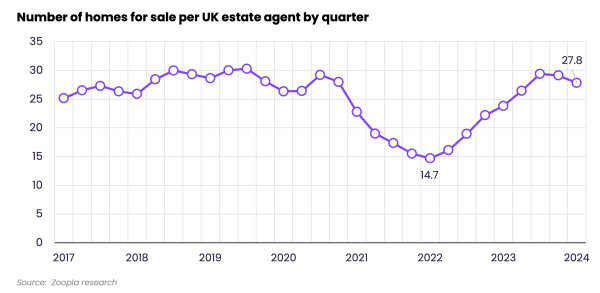
More supply and weaker demand led to a drawn out re-pricing of homes listed for sale over 2023, as sellers adjusted asking prices lower in order to attract demand.
This accelerated in the second half of 2023 as higher mortgage rates hit buying power.
Asking price reductions for homes listed for sale have picked up again in January 2024, which is a sign that house prices are still adjusting to higher borrowing costs.
They aren’t as high as this time last year but are higher than those seen in previous years, as sellers speak to their agents about how to pitch their home at the right price level to attract renewed interest.
Half of owners with a mortgage still need to move onto higher mortgage rates
Buyers remain price sensitive and many with mortgages are still yet to remortgage onto higher rates.
The Bank of England estimates that around 55% of mortgage accounts (around 5 million), have remortgaged since rates started to rise in late 2021.
Higher mortgage rates are expected to affect around a further 5 million households by 2026.
For the typical owner-occupier mortgagor rolling off a fixed rate between 2023 Q2 and the end of 2026, their monthly mortgage repayments are projected to increase by around £240, or around 39%.
The good news is that the more mortgage rates decline, the smaller the jump in repayments.
However, for those looking to buy a home and trade-up for more space or a nicer area, this means spending more and taking on a larger loan, adding to monthly mortgage payments.
With inflation not falling as fast as economists expected, the decline in mortgage rates is set to moderate, despite intense competition between banks.
The cost of mortgages is set to keep buyers focused on value for money, even as mortgage rates fall, keeping prices in check.
It's still a buyers market and sellers need to price carefully
The average UK seller is having to accept offers below the asking price and the typical discount from the asking price to the agreed sale price is around 5%.
This is slightly below the long run average and well down on the hot market conditions seen over the pandemic years.
This proportion is not growing, which means larger price falls are unlikely. But it shows sellers will need to price carefully to ensure they attract demand.
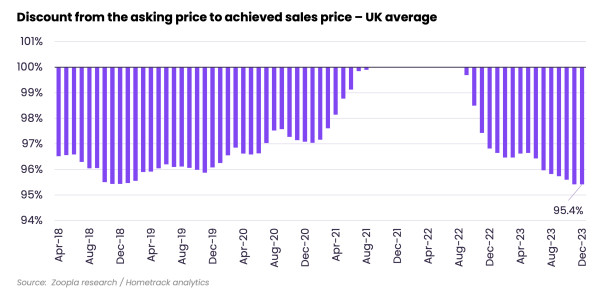
The proportion of sellers achieving their asking prices varies across the UK, with slightly larger discounts happening in southern England.
Here, prices are higher than the national average and for that reason, the impact of higher mortgage rates on pricing levels has been greater than in other regions.
How should sellers and buyers respond to the positive start to 2024?
The positive news at the start of 2024 should boost market confidence and encourage more buyers and sellers into the market.
But it’s important sellers don’t get too carried away and shift expectations on what their home is worth in 2024 versus 2023.
It all depends on what you are looking to sell and how closely this matches to who is in the market looking to buy in your area and price range.
For example, we expect first time buyers to remain a very important group in 2024. However, this group is not focused on buying larger homes, where there is more supply.
Larger homes will mainly appeal to upsizers, who are likely to need bigger borrowings to buy at higher mortgage rates than 2-3 years ago.
We don’t expect house prices to suddenly start rising in 2024, but more demand and sensible pricing of homes for sale is likely to boost housing sales and overall levels of activity.
Key takeaways
- We are still locked in a buyers market, so it’s unlikely we'll see prices rise in 2024 at a national level
- House price falls were modest in 2023, despite mortgage rates more than trebling since 2021
- But buyers remain price sensitive and 45% of those with mortgages are yet to remortgage onto higher rates
- Inflation appears sticky, meaning there is only so far mortgage rates are likely to fall
- The average UK seller is having to accept offers and is getting around 95% of the asking price, so sellers must remain realistic on pricing
Renters paying an extra month's rent per year after latest rises
Rents jumped 9% in the last year, adding £1,200 - a month’s worth of rent - to the average annual bill.
2023 was another tough year for renters, with average rents for new lets reaching £1,200 in November - 9% higher than a year ago.
It means renters have seen an extra £1,200 - or a month’s worth of rent - added to their annual bill.
The table shows how much rents for new lets have increased across the UK in the last year.
| Region | Annual rental increase (%) | Annual rental increase (£) | Average monthly rent |
|---|---|---|---|
| Scotland | 12.1% | £84 | £780 |
| North West | 10.8% | £81 | £831 |
| Wales | 10.1% | £78 | £852 |
| North East | 9.7% | £60 | £672 |
| East Midlands | 9.7% | £75 | £846 |
| East of England | 9.5% | £99 | £1,145 |
| South East | 9.3% | £110 | £1,294 |
| West Midlands | 8.8% | £72 | £883 |
| South West | 8.6% | £83 | £1,061 |
| London | 8.0% | £157 | £2,128 |
| Yorkshire | 7.7% | £56 | £782 |
| Northern Ireland | 4.9% | £35 | £750 |
Zoopla Rental Index, data to November 2023 published in January 2024
Rental inflation in Scotland boosted by rent controls
In September 2022, the Scottish Parliament introduced a rent cap of 3% on annual rises to existing tenancies.
While intended to reduce cost-of-living pressures for renters, it means landlords are now going higher at the start of a tenancy to cover their costs and the limited increases during the contract.
In fact, Scotland has registered the highest level of annual rental inflation in the UK at +12.1%. The average monthly rent in Scotland stands at £780, £84 more than a year ago.
This is a slower rate of growth than the highs of +13.7% back in February 2023, but we still expect Scotland to see faster rental growth than anywhere else in the UK in 2024.
In turn, Scottish cities continue to register some of the largest rent increases in the country. Over the last 12 months, the average monthly rent in Edinburgh increased by £150 and in Glasgow by £100.
Rental inflation is much less dramatic in rural parts of Scotland, with Ayrshire, Moray and the Highlands all recording growth below +7%.
London leads the slowdown in rental growth
Rental inflation has slowed down in southern cities in the last 12 months, giving some relief to renters in the expensive South of England.
The largest moderation is in London, where rental inflation has dropped from +15.9% a year ago to +8.1% today.
Rental growth has slowed the most in Inner London boroughs. A year ago, we were seeing rises of +14.9% in Hammersmith and Fulham and up to +21.1% in Tower Hamlets. Today, no inner borough is seeing growth of more than +9.5%.
However, outer boroughs are a different story, seeing some of the highest rent increases in England right now. Rents have risen by more than +13.5% in boroughs like Hillingdon, Redbridge and Barking and Dagenham.
The second and third largest slowdowns are recorded in Bristol and Newport, where rental inflation has fallen to +7.9% and +8.8% respectively.
These reductions suggest landlords are becoming more realistic in pricing their rentals and may be taking cost-of-living struggles into consideration when setting new rates, which tend to be exacerbated for those in the rental market.
What are renters doing to minimise the impact of higher rents?
Some renters have escaped the steepest rises by staying in their existing homes.
Year-on-year rises for established tenancies rose at the slower rate of 6.2% according to the Index of Rental Prices from the Office for National Statistics.
When renters move and are faced with higher rents and a limited supply of homes on the market, they're more commonly considering renting smaller homes, moving to cheaper areas or house-sharing to reduce costs.
House-sharing reduces the cost of housing per person but it comes at the personal expense of privacy and space. Data from the Resolution Foundation found private renters have experienced a 16% reduction in floor space per person over the last 20 years.
What’s next for the rental market?
We believe that the rental market is now past peak rental growth after starting to cool in the final months of 2023.
We expect a further slowdown in rental growth in 2024 as worsening affordability keeps demand in check and supply improves slowly. There are already signs asking rents have overshot in some markets that are showing resistance to higher rents.
Slower increases will be welcome news to renters who have often faced steep hikes in the last two years.
Key takeaways
- A 9% rise in average monthly rent has added £1,200 to the average annual bill since this time last year
- Renters are now paying £1,200 per month on average, ranging from £672 in the North East to £2,128 in London
- Rental growth slowing to single digits is a sign we're past peak growth after nearly two years of 10%+ increases
- Scotland continues to register the highest rental growth despite rent controls
- London and the South of England are seeing rent growth slow the most as rents hit an affordability ceiling
- We expect a further slowdown in rental growth in 2024 as worsening affordability keeps demand in check
Buyers return amid falling mortgage rates
The first full week back after the new year has seen buyer interest jump out of the blocks faster than last year as mortgage rates drop. Get the latest with Richard Donnell.
The start of 2024 has seen a slew of more positive news on the housing market.
Over the last month, we’ve seen further signs that house price falls are slowing, alongside a further drop in average mortgage rates for new borrowers with some very competitive deals at 60% loan to value.
This reflects what we reported in our most recent house price index: a 17% increase in new sales agreed as buyers sought to lock down new deals at the end of 2023.
This improvement in market activity looks to be rolling over into the start of 2024, driven by improving mortgage rates.
London and South East lead fast start to 2024
The first full week back after the new year has seen buyer interest jump out of the blocks faster than last year and the pre-pandemic period in 2019.
It’s early days but our data shows demand at the end of the first week of January was more than 10% ahead of the same period a year ago.
Demand has jumped most in London and the South East, where house price gains over recent years have been much lower than the rest of the UK, which has helped improve housing affordability.
Modest house price falls over 2023
Our UK house price index shows that prices are 1.1% lower than a year ago, with signs that the scale of price falls is slowing.
Sales volumes are now starting to improve with buyers returning to the market.
While the Zoopla house price index has recorded a modest fall in UK house prices over the last 12 months, the profile of price changes varies widely across the UK.
The largest price falls are up to 4% and concentrated across southern England in markets which saw the greatest demand over the pandemic, including those in the East of England and Kent.
Prices are also falling in areas where there has been strong demand for second homes, such as North Wales and the South West.
In contrast, house price inflation remains positive in many areas across northern England and Scotland. The rate of price gains has slowed quickly from double digit growth at the end of 2022 to close to 0% now but prices aren’t falling everywhere.
The greatest downward pressure on prices has been in southern England, where higher house prices mean a greater impact from higher mortgage rates.
This is where sellers are having to accept larger discounts to the asking price to achieve a sale, averaging around 6%.
While house prices are highest in London, they aren’t leading the fall. That's because the London market has lagged behind the rest of the country in terms of price growth over the last 6 years, making homes slightly less expensive and more accessible to buyers.
Annual house price inflation by postcode area November 2023
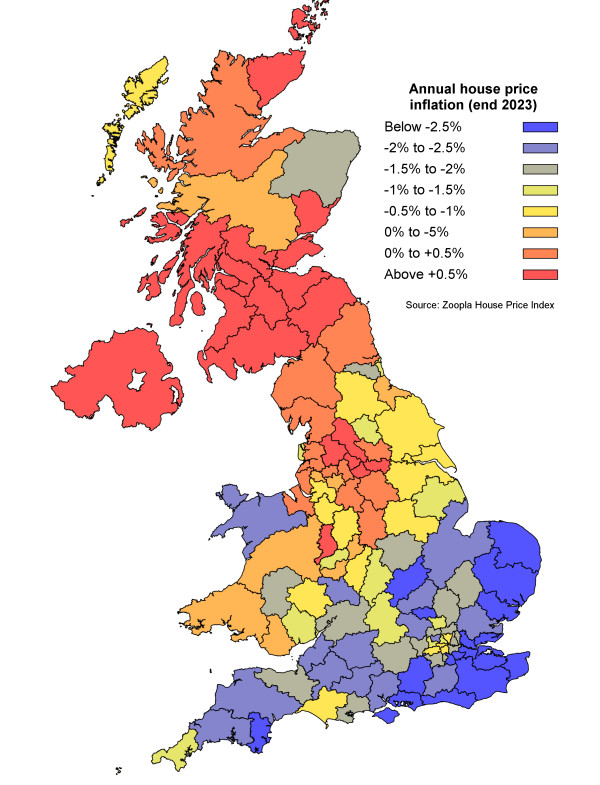
Nearly all homeowners are sitting on gains vs the start of the pandemic
House price falls have been modest, despite higher mortgage rates, because of the mortgage regulations introduced in 2015 by the Bank of England.
These regulations stopped the development of a bubble in house prices and are a key reason why price falls have been small over 2023.
The net result is that most areas have house prices still well above the levels they were before the pandemic hit the market, which created a boom in demand for housing.
The average UK home is now worth 18% (or £41,000) more than it was at the start of the pandemic in March 2020.
The map below shows the difference in house prices between March 2020 and November 2023.
It shows that the Northern regions, Wales and the South West are where house prices pushed highest during the pandemic - and that average prices in these regions are still over 24% higher than their pre pandemic levels.
Price gains have been more modest in and around London, where affordability pressures and mortgage regulations have limited the scope for price gains.
So for those looking to sell and move in 2024, the vast majority of homeowners are sitting on price gains compared to the pre-pandemic period.
It’s a much better position than many people predicted we would be in a year ago, although not us however.
House price growth since the start of the pandemic March 2020

What does this mean for buyers and sellers?
We certainly expect news of lower mortgage rates to boost buyer demand and bring more interest into the market over the coming months.
Buyers understand that there is more room to negotiate on pricing with sellers but many will also still need to sell a home to unlock their next move.
Sellers will need to remain realistic over the value they expect to achieve from their property and be prepared to negotiate on price.
We saw a steady reduction in asking prices over 2023, as sellers worked with their estate agents to get the pricing right to attract demand and increase the chances of securing a sale.
Much depends on the type of property you're selling and its location, so it’s essential to speak to your local agent to get a view of demand for a home like yours in the current market.
Key takeaways
- The number of buyers out home hunting has shot up 10% compared to this time last year
- House price falls are starting to slow as sales agreed rise by 17%
- The average UK home is worth 18% (or £41,000) more than it was in March 2020
- Mortgage rates drop further with some very competitive rates for borrowers with a 60% LTV
House Price Index: December 2023
House price inflation running at -1.1% as market sentiment improves with demand up and more sales agreed. Get the latest in our December House Price Index with Richard Donnell.
Sales hold up in Q4 2023, providing support for prices
The final weeks of 2023 have recorded above average levels of new sales, 17% higher than a year ago.
Market sentiment is improving due to rising incomes and an initial decline in mortgage rates. Demand is also 19% higher than a year ago.
An increase in available supply, up a quarter on last year, is also boosting choice and supporting sales. Buyers and sellers are becoming more aligned on pricing, reducing the downward pressure on values.
Our headline UK house price index has recorded a slower pace of annual price decline at -1.1% in November 2023, down from +7.2% a year ago.
And price falls have now moderated across all regions and countries of the UK.
House price indices can show varied trends when the market turns
UK house price indices track well over time, but they tend to separate at key moments as the volume and mix of sales changes.
The Zoopla house price index is based on the largest dataset of any UK house price index.
It has performed inline with the ONS house price index, with both series including cash and mortgaged sales.
In 2023, cash purchases look set to account for a third of all sales and are therefore an important source of pricing evidence.
The average price of a cash purchase is 10% lower than the average mortgage funded sale. This makes cash purchases slightly more affordable, especially since there is no mortgage process or valuation required to enable a sale.
Mortgaged sales are on track to be 30% lower over 2023 as higher mortgage rates hit demand. Because of this, mortgage lenders’ house price indices responded quickly to weaker demand, recording steeper price falls over 2022 Q4 and 2023 H1.
However, the annual growth rate in house prices recorded by lenders has improved in recent months as market activity and pricing stabilises, bringing it back towards the Zoopla/ONS series.
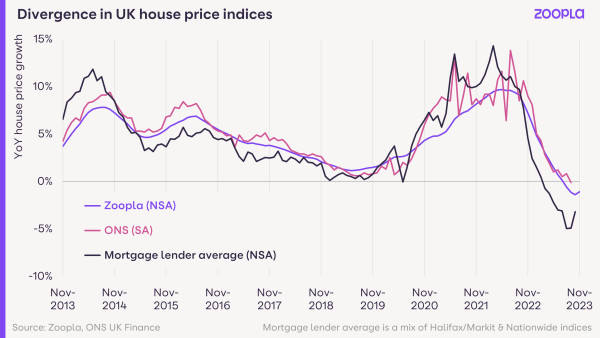
Why haven’t house prices fallen more in 2023?
History suggests that mortgage rates rising from 2% to over 5% would have led to larger price falls than what has been recorded over 2023.
There are several reasons why prices have defied the predictions of larger falls:
1. The strength of the labour market has been an important factor along with high growth in average earnings.
2. Lenders have also pursued forbearance policies to support households struggling with repayments, which has limited the number of forced sellers.
3. And perhaps the most important factor of all: the introduction of tougher mortgage affordability testing for new borrowers since 2015.
These regulations were designed to stop households taking on excessive debts at a time of low mortgage rates.
They have stopped a major housing overvaluation and built resilience for many households to manage the transition to higher mortgage rates.
While mortgage rates got as low as 1.3% in late 2021, all new mortgage borrowers had to prove to their bank that they could afford a 6-7% stressed mortgage rate to get the loan (see chart below).
Banks were also limited to 15% of new business at high loan to income ratios over 4.5x.
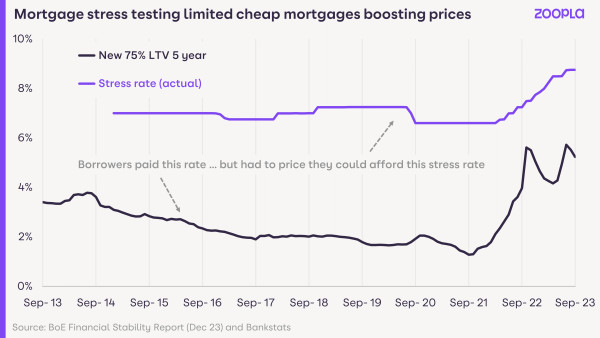
These regulations have effectively capped buying power for home buyers.
They require the borrower to have a higher income to buy and put down a larger deposit, which is especially true in higher value housing markets.
ONS data shows that first-time buyers in London put down an average deposit of £145,000 in 2022, compared to £26,000 for those buying in the North East.
Today, lenders are stress testing new borrowers at close to 9% despite mortgage rates starting to fall.
This regulatory constraint on buying power is one reason we believe house prices are unlikely to rise in 2024, even as base rates start to fall later in the year.
First-time buyers to remain largest buyer group in 2024
Despite the affordability challenges facing first-time buyers, they will be the largest group of would-be buyers in the next 2 years.
Our latest consumer survey of home moving intentions found that 40% of people looking to buy a home in the next 2 years are first-time buyers.
The rapid growth in rents continues to motivate this group - average rents have risen faster than average mortgage repayments over the last 3 years - despite the need for higher deposit levels.
Upsizers account for a third of would-be buyers in the next 2 years, who will typically be buying a larger home that will require a larger mortgage.
This group has been biding their time in 2023, waiting for the outlook on the economy and mortgage rates to become clearer. The trajectory for mortgage rates and getting better value for money will be key considerations for upsizers in 2024.

Buyers look further afield for better value
Almost a quarter of would-be home movers say they are looking to move to a different location.
A high proportion of home moves tend to be limited to within local areas - the average distance buyers are looking to move when searching on Zoopla is 4.3 miles.
However, in the face of higher borrowing costs and the search for value, one of the key trends for 2024 will be buyers continuing to look further afield in search of better value.
This is particularly the case in high value housing markets where upsizing is expensive.
Our data shows that almost half of would-be movers currently living in southern regions are looking to move more than 10 miles. The proportion looking longer distances in other parts of the UK is lower.
This is important for home builders and estate agents who tend to focus on demand and needs in local areas whereas there is the need to capture and nurture demand coming from further afield, especially as these buyers may well have more money to spend.
Outlook for 2024
We expect the steady momentum in new sales that has developed over the final quarter part of 2023 to continue into early 2024, with the usual seasonal rebound in demand over Q1 as pent-up demand returns to the market.
While mortgage rates are edging lower, affordability remains a key challenge for mortgage reliant households who are making home moving decisions.
The impact of higher mortgage rates continues to feed through with half of mortgagees yet to move onto higher rates from cheaper fixed rate deals agreed before 2022.
The modest decline in house prices over the year means UK housing still looks 10-15% overvalued at the end of 2023. We expect this position to improve over 2024 as incomes rise and house prices drift 2% lower over the year. Sales volumes are expected to hold steady at 1 million sales completions over 2024.
Key takeaways
- Annual UK house price inflation running at -1.1% (compared with +7.2% in Nov-22)
- Market sentiment improving with new sales agreed running 17% higher than a year ago, demand is also 19% higher as buyer sentiment improves
- House price falls starting to moderate as sales volumes improve
- Mortgage regulations a key reason for only modest price falls in 2023 along with strong labour market and rapid earnings growth
- First-time buyers are largest group of would-be movers in next 2 years (40%) followed by upsizers (34%)
- Almost half of buyers living in southern England looking to move more than 10 miles, in search of better value for money
- House prices to fall 2% over 2024 with 1m sales
Are UK house prices falling in December 2023?
UK house prices have fallen -1.1% in the last year, bringing the average house price to £264,500. So where’s faring worst, and is anywhere escaping the price falls so far? Let’s find out what’s happening with house prices in December 2023.
The average UK house price is now £264,500. That’s £2,990 lower than a year ago and £100 lower than last month.
However, the rate of house price falls has moderated across all regions and countries of the UK. Buyers and sellers are becoming more aligned on pricing, reducing the downward pressure on values.
Our UK House Price Index has recorded a slower pace of annual price decline at -1.1% in the last year (versus +7.2% a year ago). Prices fell -1.1% in the year to November 2023, -1.4% in the year to October and -1.2% in the year to September.
Where are UK house prices falling in December 2023?
Regions
Homeowners in Southern England are seeing the biggest fall in house prices. The East of England (-2.7%), the South East (-2.4%) and the South West (-2.2%) are the worst hit, as higher mortgage rates reduce demand the most in more expensive regions.
On the other hand, property prices are now +2.1% and +1.3% higher than a year ago in Northern Ireland and Scotland respectively.
Lower average house prices here means many people can still afford to buy a home with a higher mortgage interest rate. This keeps the housing market moving and gives less need for sellers to reduce their prices.
Cities
Cities in the South of England are seeing the biggest house price falls, with Southampton (-2.8%) hit harder than any other UK city.
Fellow south coast cities Portsmouth (-2.4%) and Bournemouth (-2.1%) are among the larger price falls, along with Cambridge (-2.6%) in the East, Leicester (-2.0%) in the East Midlands and Bristol (-1.9%) in the South West.
These Southern cities enjoyed strong buyer demand and significant price growth during the pandemic. But now demand is falling and supply is growing, there is downward pressure on local property prices.
On the other hand, house prices are still rising slowly in more affordable cities in Scotland, Northern Ireland and the North of England. This includes Belfast (+3.2%), Glasgow (+1.3%), Edinburgh (+0.9%) and Newcastle (+0.5%).
Local authority areas
Parts of Kent and Norfolk are seeing the biggest house price falls in the country. Many of these popular areas saw prices rise sharply during the pandemic due to strong demand in the ‘race for space’ or lifestyle influences.
But now they’re seeing demand fall and supply grow due to higher mortgage rates, putting the negotiating power in buyers’ hands.
| Local authority area and county | Annual house price change (%) | Annual house price change (£) | Average house price |
|---|---|---|---|
| Dover, Kent | -4.5% | -£13,960 | £297,900 |
| Canterbury, Kent | -4.5% | -£15,790 | £343,800 |
| Thanet, Kent | -4.3% | -£13,180 | £293,300 |
| Broadland, Norfolk | -4.1% | -£13,460 | £318,000 |
| North Norfolk, Norfolk | -4.1% | -£13,230 | £313,100 |
| South Norfolk, Norfolk | -4.1% | -£13,640 | £322,600 |
| Breckland, Norfolk | -4.0% | -£11,510 | £273,300 |
| Great Yarmouth, Norfolk | -4.0% | -£8,060 | £193,200 |
| Norwich, Norfolk | -4.0% | -£9,480 | £226,200 |
| Waveney, Suffolk | -4.0% | -£10,120 | £241,900 |
Zoopla House Price Index, December 2023
Why are UK house prices falling?
Higher interest rates on mortgages have made it harder for people to buy a home, which reduces demand for property. At the same time, there are many more homes on the market than in recent years.
These factors together create a buyers’ market - when buyers have more choice so sellers are under pressure to price more competitively in order to sell.
However, the market is in a much better condition than this time last year, when the fall-out from the mini budget was still fresh. Buyer demand is up +19% on a year ago which is helping +17% more new sales agreed. There is also an increase in available supply, up a quarter on last year, which is boosting choice and supporting sales.
Why haven’t house prices fallen further in 2023?
History suggests that mortgage rates rising from 2% to 5%+ would have led to larger house price falls than those we’ve recorded in 2023.
But there are several reasons to explain the more modest falls.
The strength of the labour market and high growth in average earnings are important factors.
Lenders’ forbearance policies are supporting households struggling with repayments, which has limited the number of forced sellers.
Perhaps most important is the tougher mortgage affordability testing for new borrowers since 2015. New regulations were designed to stop households taking on excessive debt and artificially inflating house prices.
This has prevented a major housing overvaluation and made sure that most households can manage the transition to higher mortgage rates.
While mortgage rates dropped as low as 1.3% in late 2021, new mortgage borrowers had to prove they could afford a 6% to 7% rate. At the same time, banks were only allowed to lend 15% of new customers more than 4.5 times a salary.
These regulations mean mortgage borrowers must have a higher income and put down a larger deposit. The higher the house prices, the more they need.
The chart shows the rate at which lenders have stress-tested over the last 10 years versus the mortgage rate borrowers have paid.
Will house prices keep falling in 2024?
Yes, our data suggests that house prices will keep falling slowly next year.
After three years of strong price growth up until 2022, higher mortgage rates are resetting the price people can afford to buy at.
Despite a modest decline in house prices over 2023, UK housing still looks 10-15% overvalued at the end of the year. We expect this position to improve during 2024 as incomes rise and house prices drift 2% lower. Sales volumes are expected to hold steady at 1 million sales completions over 2024.
Lenders are stress-testing new borrowers at close to 9%, despite actual mortgage rates starting to fall. This regulatory constraint on buying power is one reason we believe house prices are unlikely to rise in 2024 even if the Bank Rate starts to fall later in the year.
Mortgage rates need to drop further to improve affordability and encourage people to move.
How far house prices will fall hinges on the trajectory for mortgage rates and how mortgage lenders assess affordability. Some economists forecast that the Bank of England will start cutting rates around summer 2024. This would see mortgage rates falling and mean an uplift in housing market activity towards the end of next year.
Key takeaways
- House prices are falling in all property price bands and areas of England and Wales
- The biggest annual falls are in the East of England (-2.7%), the South East (-2.4%) and the South West (-2.2%)
- Southampton, Aberdeen, Cambridge and Portsmouth are worst hit in terms of UK cities
- Parts of Kent and Norfolk are seeing the largest house price falls as they feel the impact of high mortgage rates and low demand
- Northern Ireland (+2.1%) and Scotland (+1.3%) are the only UK regions where house prices are rising, while the North East has seen no annual change
- Property prices remain well above what they were before the pandemic, even in the places with the biggest house price falls
House price falls start to slow
Buyers and sellers are becoming more aligned on pricing, reducing the downward pressure on house prices and falls are starting to moderate.
The housing market is looking more buoyant than it did this time last year following the mini budget.
New sales agreed are running 17% higher than in November 2022, while buyer demand is up 19%.
However, housing market confidence was badly knocked in November 2022 following Kwasi Karteng’s Autumn Statement. The Bank Rate jumped to 3% and the average mortgage rate for a five-year fixed deal pushed northwards of 6%.
Today, we’re seeing an initial decline in mortgage rates, with the average five-year fixed deal now sitting at 4.74% for those with a 25% deposit.
This, along with rising incomes, is helping to boost buyer confidence.
Meanwhile, an increase in the number of homes available for sale - up 25% on last year - is boosting choice and supporting sales.
Buyers and sellers are also now also becoming more aligned on pricing, reducing the downward pressure on house prices and falls are beginning to moderate.
Thinking of selling?
Get the ball rolling with an in-person valuation of your home. It’s free and there’s no obligation to sell if you change your mind.

Property sales supported by cash buyers in 2023
This year, cash buyers are on track to account for 30% of all house sales. Conversely, the number of mortgaged sales fell by 30%, as higher mortgage rates hit demand.
Yet house prices didn’t tumble despite the hit to buying power. Why?
1: The labour market has remained strong throughout 2023 and wages have continued to rise.
2: Lenders have support measures in place to help those who are struggling to pay their mortgages - and this has limited the number of forced sales from homeowners.
3: Finally, and perhaps most importantly of all, lenders have had strict affordability testing measures in place since 2015, preventing buyers from taking on excessive debts at a time of low mortgage rates.
Even when mortgage rates were sitting at 1.3% back in 2021, mortgagees had to prove that they could still repay their debts if those rates increased to 6-7%.
Banks were also restricted in their ability to lend 4.5x or more of a borrower’s salary. Only 15% of their loans were allowed to be this large.

Today, lenders are stress testing new borrowers at close to 9%, even though mortgage rates are starting to fall.
Our Executive Director of Research, Richard Donnell, says: ‘This regulatory constraint on buying power is one reason we believe house prices are unlikely to rise in 2024, even as base rates start to fall later in the year.’
Who will be the big movers in 2024?
Our latest consumer survey reveals first-time buyers are set to be the biggest group of buyers next year, accounting for 40% of all sales.
Average rents have risen faster than average mortgage repayments over the last three years, which is a key motivator for this buying group.
They’ll be hotly followed by upsizers (34%), who have been biding their time this year amid mortgage rate uncertainties.
Buyers in expensive regions set sights on homes further afield
To help mitigate higher mortgage rates, we’re expecting to see buyers looking further afield in 2024.
Currently, the average distance buyers are looking to move when searching on Zoopla is 4.3 miles.
Yet our data shows that buyers in the south, where homes are more expensive and need bigger mortgages, are looking to move more than 10 miles at the moment to secure a good value home.
What’s going to happen in the housing market next year?
‘We expect the steady momentum in new sales that has developed over the final part of 2023 to continue into early 2024,’ says Donnell.
‘While mortgage rates are edging lower, affordability remains a key challenge for mortgage-reliant households who are making home moving decisions.’
In fact, half of mortgagees are yet to move onto higher rates from the cheaper fixed rate deals they agreed before 2022.
‘The modest decline in house prices over the year means UK housing still looks 10-15% overvalued at the end of 2023,’ says Donnell.
‘We expect this position to improve over 2024 as incomes rise and house prices drift 2% lower over the year.
‘Sales volumes are expected to hold steady at 1 million sales completions over 2024.’
Key takeaways
- Market sentiment is improving and house prices are holding steady
- The number of new sales agreed is currently 17% higher than in November 2022 and buyer demand is up 19% on this time last year
- Sellers in the south are likely to attract buyers from further afield in 2024 as they search out new areas to secure good value homes
The highest yielding areas for buy-to-let property in the UK
Considering becoming a landlord? One strategy for investment is to focus on higher yielding markets. Here are the top investor hotspots in the UK.
Ready to become a landlord and want the biggest return on your investment?
It’s worth getting to grips with rental yield if you’re purchasing a buy-to-let property.
Gross rental yield is the annual rental income expressed as a percentage of the property price. Net rental yield also factors in the cost of maintaining and renting out the rental property. Both can help you decide if a property is a good investment.
Keep in mind that tenant demand and the potential for house price growth - among other factors - should also be considered with property investment.
The average gross rental yield in the UK is currently 5.49%. The average buy-to-let property costs £262,288 and the UK’s average rent is £1,201.
Yields have improved across all regions in the last year as house prices have started to fall and rents have continued to rise.
10 top cities for rental yields in the UK
Sunderland, Dundee and Burnley top the chart for the highest rental yields in the UK, with average gross yields of close to or higher than 8%.
Cities in the North of England and Scotland are generally better for yields than the South of England and London. This is because house prices are disproportionately higher than rents in these southern locations.
Glasgow and Liverpool also make our list with gross yields of 7.90% and 7.43% respectively. These cities provide attractive opportunities for property investors due to their relatively low average house prices, excellent employment prospects and large student populations.
Here are the top 10 cities for rental yields right now.
| City | Average gross rental yield | Average monthly rent | Average price of a buy-to-let property |
|---|---|---|---|
| Sunderland | 8.50% | £598 | £84,432 |
| Dundee | 8.07% | £783 | £116,498 |
| Burnley | 7.96% | £561 | £84,575 |
| Glasgow | 7.90% | £930 | £141,180 |
| Middlesbrough | 7.85% | £604 | £92,292 |
| Aberdeen | 7.45% | £673 | £108,436 |
| Liverpool | 7.43% | £798 | £128,905 |
| Blackburn | 7.41% | £656 | £106,209 |
| Hull | 7.30% | £594 | £97,602 |
| Grimsby | 7.07% | £602 | £102,208 |
Rental Index, December 2023
Top regions for rental yields in the UK
When it comes to regions, the top places for rental yields are all northern.
Rents in the North East are cheaper than anywhere else in the country (£671) - but so are buy-to-let properties, at £109,715 on average. This gives the region the highest average yield in the UK of 7.34%.
It’s followed by Scotland (7.32%), the North West (6.52%), Northern Ireland (6.24%) and Wales (6.23%).
London offers the lowest gross yields in the UK of 4.92% on average. With higher mortgage rates, new regulations and low house price growth in recent years, landlord investment in the city has been limited. Particularly as rents appear to have reached an affordability ceiling and tenant demand is starting to moderate.
The South East and East of England also offer lower gross yields of 5.17%. These are the two regions where house prices have fallen the most, which has improved their rental yield from between 4.50% and 5.0% a year ago.
| Region | Average gross rental yield | Average monthly rent | Average price of a buy-to-let property |
|---|---|---|---|
| North East | 7.34% | £671 | £109,715 |
| Scotland | 7.32% | £777 | £127,326 |
| North West | 6.52% | £828 | £152,369 |
| Northern Ireland | 6.24% | £746 | £143,462 |
| Wales | 6.23% | £848 | £163,283 |
| Yorkshire and the Humber | 6.23% | £781 | £150,504 |
| West Midlands | 5.78% | £881 | £182,947 |
| East Midlands | 5.70% | £845 | £177,816 |
| South West | 5.23% | £1,058 | £242,532 |
| East of England | 5.17% | £1,143 | £265,351 |
| South East | 5.17% | £1,291 | £299,890 |
| London | 4.92% | £2,125 | £518,056 |
Zoopla Rental Index, December 2023
The highest yielding areas in each part of the UK
Looking for a buy-to-let property near where you live can be useful. You know the local area, understand local influences on the market and can work closely with a local letting agent.
And it helps to know which parts of your region offer the greatest rental yield. Here are the top 3 local authorities for average yields in each UK region.
North East
-
Middlesbrough - 8.52% gross rental yield
-
Sunderland - 8.50% gross rental yield
-
Hartlepool - 8.31% gross rental yield
Scotland
-
East Ayrshire - 9.57% gross rental yield
-
West Dunbartonshire - 9.15% gross rental yield
-
Renfrewshire - 9.13% gross rental yield
North West
-
Burnley - 8.41% gross rental yield
-
Liverpool - 7.57% gross rental yield
-
Hyndburn - 7.47% gross rental yield
Wales
-
Blaenau Gwent - 7.38% gross rental yield
-
Neath Port Talbot - 7.23% gross rental yield
-
Merthyr Tydfil - 7.22% gross rental yield
Yorkshire and the Humber
-
Hull - 7.30% gross rental yield
-
North East Lincolnshire - 7.07% gross rental yield
-
Barnsley - 7.02% gross rental yield
West Midlands
-
Stoke-on-Trent - 7.09% gross rental yield
-
Newcastle-under-Lyme - 6.52% gross rental yield
-
Coventry - 6.46% gross rental yield
East Midlands
-
Nottingham - 7.06% gross rental yield
-
Mansfield - 6.40% gross rental yield
-
Boston - 6.39% gross rental yield
South West
-
Plymouth - 6.32% gross rental yield
-
Gloucester - 6.20% gross rental yield
-
Swindon - 6.06% gross rental yield
East of England
-
Great Yarmouth - 6.13%
-
Fenland - 6.05%
-
Peterborough - 6.04%
South East
-
Southampton - 6.42% gross rental yield
-
Gosport - 6.10% gross rental yield
-
Portsmouth - 6.09% gross rental yield
London
-
Barking and Dagenham - 6.24%
-
Newham - 5.78%
-
Bexley - 5.62%
What’s the outlook for buy-to-let property investment in the UK?
Tenant demand is a third higher than the 5-year average while supply is limited by low new investment. We expect rents to rise between 5% and 8% next year as there is still affordability headroom across most of the country.
There is also further for house prices to fall. If house prices are falling and rents are rising, gross yields will continue to improve.
However, there are signs that the rental market is about to turn and we have already passed the peak of rental growth. We expect annual UK rental growth to halve to 5% to 8% during 2024, the lowest growth since 2021.
There are already signs that rental demand is weakening. Influencing factors include the ending of one-off pandemic after-effects, slower jobs and wage growth, and mortgage rates dropping since a year ago.
Key takeaways
- If you’re looking for a buy-to-let property, rental yield can help you decide if the cost of the property is worth the potential rental income
- Rental yields have improved in the last year due to falling house prices and increasing rents
- The highest yielding cities in the UK are Sunderland, Dundee and Glasgow, which offer a gross rental yield of between 7.7% and 8.4%
- The North East is the best best for investors looking for strong yields, offering an average of 7.15%
- We reveal the three highest yielding areas in every region of the UK
- Take other factors into account before you invest, like tenant demand and the potential for future house price growth
The cheapest places to rent a home in 2023
Renters will be pleased to learn the UK rental market has now passed its peak rate of growth. So where are the cheapest places to rent right now?
The cost of renting a home has risen rapidly over the last three years due to a chronic shortage of supply.
Rental prices have increased by a third in that time, adding £3,360 to the average renter’s bill.
But in good news for renters, we’re anticipating a major deceleration in prices for new lets during 2024.
The cost of new lets has now reached the ceiling of what renters are able to afford.
This will lead to a slowdown in demand and a gradual increase in the availability of homes to rent.
Our Executive Director of Research, Richard Donnell, says: ‘There are already signs asking rents have overshot in some markets showing resistance to higher rents.
‘Our data shows that rental demand has been steadily losing momentum over second half of 2023.
'This is illustrated by the number of enquiries per home for rent. This measure peaked at over 35 enquiries per property in the summer of 2022.
'There was a seasonal peak this summer, but to a lesser degree. We are now in the usual seasonal slowdown that will extend into Q1 2024.’
London to lead the way in reducing rents
One third of the UK’s rental homes are based in London and it's set to lead the way in reducing the price of new lets next year.
The capital is the most expensive place to rent a home in the UK and prices for new lets here have already hit the ceiling for renters.
A year ago, rents here were rising at a rate of 17%. Today, that rate has dropped to 9.7%.
Across the rest of the UK, rents were rising at 11.9% a year ago. Today they are also rising at 9.7%.
In 2024, average UK rents are expected to rise by 5%, the lowest growth rate since in 2021.
Scotland bucks this trend however. Here, rental growth is continuing to gain momentum with rents up 12.9%, compared to 11.4% a year ago.
That's largely because rents have been capped here, meaning landlords may only increase rents by 3% during a tenancy. That has led landlords and letting agents to push up prices for new lets in advance of them being rented out.
The cheapest places to rent in the UK - regions
For the cheapest rents in the country, the North East is where it’s at. Tenants spend an average of £671 per month on rent here.
Northern Ireland, Scotland and Yorkshire and the Humber all sit at the cheaper end of the scale too, with rents averaging less than £800 per month.
Rents in the South of England are much more expensive than anywhere else in the country.
London is by far the most expensive region to rent in the UK (£2,125 per month), followed by the South East (£1,291), East of England (£1,143) and South West (£1,058).
| Region | Average rent | Annual rental price change | Annual % change |
|---|---|---|---|
| North East | £671 | £60 | 10.5% |
| Northern Ireland | £746 | £20 | 3.2% |
| Scotland | £777 | £90 | 12.9% |
| Yorkshire & The Humber | £781 | £60 | 7.8% |
| North West | £828 | £80 | 11.3% |
| East Midlands | £845 | £80 | 10.5% |
| Wales | £848 | £80 | 10.7% |
| West Midlands | £881 | £80 | 10.1% |
| South West | £1,058 | £90 | 8.8% |
| East of England | £1,143 | £100 | 10% |
| South East | £1,291 | £120 | 10% |
| London | £2,125 | £170 | 9% |
| UK average | £1,201 | £110 | 9.7% |
Rental Market Report, December 2023 (data to October 2023)
The cheapest UK cities to rent a home in 2023
Just because you want cheaper rent, it doesn’t mean you have to move out to the sticks.
The cost of rent varies a huge amount across UK cities, with Aberdeen, Belfast, and Newcastle offering the cheapest average rents.
The only major city where rents are below £700 per month is Aberdeen, where the architecture is gorgeous and the cost of living low.
In Belfast, rents are currently averaging £762 per month - plus it has affordable living costs compared to mainland Britain.
Renters in Liverpool are paying £798 per month to live in the UK’s friendliest city, where rents have risen 9.5% in the last year.
Cities in the Midlands tend to be more affordable, with Birmingham and Nottingham both posting average rents of below £950 per month.
Elsewhere in Scotland, you’ll find a dynamic city lifestyle and cheap rents in Glasgow, where rents average £930 per month. But Edinburgh is much pricier with an average rent of £1,259 per month.
In southern cities, you can expect to pay higher rent than anywhere else in the country. London and Cambridge have the highest monthly rents of any UK city, with Bristol also posting an expensive average rate of £1,374.
| City | Average monthly rent | Annual % change |
|---|---|---|
| Aberdeen | £673 | 9% |
| Belfast | £762 | 3.2% |
| Newcastle | £793 | 11.7% |
| Sheffield | £796 | 7.6% |
| Liverpool | £798 | 9.5% |
| Birmingham | £912 | 10.3% |
| Leeds | £923 | 7.8% |
| Glasgow | £930 | 13.2% |
| Nottingham | £932 | 11.3% |
| Manchester | £1,037 | 12.2% |
| Cardiff | £1,065 | 11.8% |
| Southampton | £1,098 | 11.3% |
| Edinburgh | £1,259 | 15.2% |
| Bristol | £1,374 | 8.8% |
| Cambridge | £1,549 | 8.6% |
| London | £2,125 | 9% |
Rental Market Report, December 2023 (data to October 2023)
The cheapest places to rent in every region
Getting cheaper rent doesn’t mean you have to move to a whole new part of the country, either.
Here’s a breakdown of the cheapest areas to rent in each UK region. It might be that you could get a cheaper rent just by moving a few miles.
| Region | Cheapest area to rent | Average monthly rent |
|---|---|---|
| North East | Hartlepool | £516 |
| Scotland | Dumfries & Galloway | £541 |
| Yorkshire & The Humber | Hull | £594 |
| North West | Burnley | £552 |
| East Midlands | East Lindsey | £643 |
| Wales | Powys | £601 |
| West Midlands | Stoke-on-Trent | £656 |
| South West | Torridge | £754 |
| East of England | Waveney | £740 |
| South East | Isle of Wight | £869 |
| London | Bexley | £1,513 |
Rental Market Report, December 2023 (data to October 2023)
Key takeaways
- Rental inflation for new lets has now dropped below 10% for the first time in 20 months
- The UK rental market is now passed peak growth and we expect rents in 2024 to halve to a growth rate of 5%. That’s the lowest growth since 2021
- London will lead the slowdown with rents expected to increase by just 2% over 2024 as affordability pressures impact demand
What happened to the housing market in 2023?
In 2023 one million homes were sold, as mortgage rates soared to over 6% and house prices fell 1.2%. Let’s take a look at the year that was.
2023 was the year we saw five bank rate rises, with mortgage rates peaking at 6.44% for a two-year fixed rate, 75% loan-to-value deal.
In the first half of the year, house prices began to fall in southern regions of the UK, but held their own in the north, where homes remain more affordable.
But by the end of 2023, prices began falling across all price bands in all regions of the UK.
In total on average, house prices fell 1.2% over the course of the year.
Bank rate rises and mortgage rate hikes
The bank rate rose five times in 2023, in three increments of 0.25% in March, May and August, plus two 0.5% rises in January and June, taking it from 3.5% in January to 5.25% today.
The effect on mortgage rates was dramatic.
The average five-year fixed rate mortgage went from 5.05% in January to peak at 6.37% in early August. It now stands at 5.22%
The average two-year fixed rate mortgage went from 5.43% in January to peak at 6.44% in July. It now stands at 5.94%.
The average standard variable rate mortgage is now an eye-watering 8.74%, up from 6.61% at the start of the year.
The volatility of mortgage rates throughout the year meant that Google was inundated with search queries on the topic: with buyers and homeowners searching up mortgage related information every 23 seconds. That’s 3,757 times a day.
In terms of housing sales, the impact to buying power was felt across the market, as buyers found their budgets effectively reduced by 20% in the face of higher mortgage costs.
What happened to house prices in 2023?
House prices fell 1.2% on average across the UK during 2023. Depending on where you live, your home's value could be down 2.6% or up 1%.
The biggest annual falls have been seen in the East of England (-2.6%), the South East (-2.4%) and London (-2.0%).
And in terms of UK cities, Bournemouth (-2.6%), Southampton (-2.3%) and Cambridge (-2.3%) have been the worst hit.
Scotland (+1%) and Northern Ireland (Belfast house prices are up +2.3%) are the only UK regions where house prices are still rising in December 2023.
The average seller discount now stands at 5.5% or £18,000 off the asking price.
That said, property prices remain well above what they were before the pandemic, even in the places with the biggest house price falls.
That meant the detached homes that became so popular during the pandemic ‘race for space’ proved harder to sell in a more expensive financial market.
Meanwhile flats started to regain popularity, being more affordable for first-time buyers.
Homes sold in 2023
|
Terraced houses |
140,000 |
|
Semi-detached homes |
130,000 |
|
Apartments / flats |
120,000 |
|
Detached homes |
89,000 |
|
Maisonettes |
9,000 |
|
Town houses |
7,000 |
|
Cottages |
6,000 |
|
Land |
4,000 |
|
Studios |
2,500 |
|
Barn conversions |
1,000 |
|
Chalets |
1,000 |
|
Mews houses |
850 |
|
Parking spots |
600 |
|
Country houses |
500 |
|
Blocks of flats |
300 |
|
Farm houses |
223 |
|
Farms |
148 |
|
Houseboats |
57 |
How long did it take to sell a house in 2023?
At the start of 2023, it took 36 days to sell a home on average but by April, that figure reduced to just 29 days. Today, it takes 38 days to sell a home.
Why? At the beginning of the year, the housing market remained fairly buoyant as mortgage rates started to come back down from the highs experienced at the end of 2022.
As rates edged closer towards 4%,demand increased alongside the number of sales agreed.
And while the actual number of homes that went under offer was 16% down on the boom years of 2020-2022, sales numbers were 11% up on 2019.
However, as the year went on, inflation remained stubbornly high and mortgage rates started to creep back up over 5% - and this put the breaks on for some buyers.
What happened to the rental market in 2023?
2023 was a difficult year for renters, with rents for new lets consistently rising at 10% or more for at least 20 months in a row.
Scotland recorded the fastest growing rents at 12.7%, where rent controls pushed landlords to maximise their rents for new lets.
Despite this, demand for rental properties remained strong - holding at 51% above the 5-year average for most of the year.
A shortage of rental properties and lack of growth in supply helped to drive up prices.
Meanwhile, rising mortgage costs affected the rental market in two ways:
-
Landlords began exiting the sector as their rental properties proved less financially viable in terms of income
-
Potential first-time buyers remained in rented accommodation for longer, biding their time in the hope that mortgage rates would start to fall again.
Over the last decade, the average rent as a percentage of gross earnings has tracked in a narrow range between 25% and 28%, averaging around 27.2%.
However, double digit rental growth over the last 20 months now means rental affordability is at its worst level for over a decade at 28.4%.
Levels of home building and net new investment by private landlords are falling and set to remain weak into 2024, largely because of higher borrowing costs.
Key takeaways
- One million homes sold in 2023
- House prices fell 1.2% on average across the UK
- The Bank of England hiked the bank rate five times
- Mortgage rates peaked at 6.44% for a two-year fixed rate
- Standard Variable Rate mortgages hit 8.74%
House prices down, mortgage rates to follow
Sellers are offering their biggest discounts in five years, with one in four offering 10% off the asking price right now, putting buyers in a strong negotiating position.
Jeremy Hunt's Autumn Statement last week revealed that inflation has now fallen from a high of 11.1% to 4.6%.
The government anticipates it will fall to 2.8% by the end of 2024 and to 2% by the end of 2025.
‘Financial markets expect the Bank of England to start cutting rates around the summer of 2024,’ says our Director of Research, Richard Donnell.
‘If mortgage rates start to fall further, this will support an improvement in demand, but prices will remain under modest downward pressure.’
The news couldn’t be better for buyers right now, who have been held back by higher mortgage rates in 2023.
Sellers are currently offering the biggest discounts in five years, with one in four offering 10% off the asking price.
The average discount being offered is 5.5%, the equivalent of £18,000.
In London and the South East, that rises to 6.1%, or £25,000, off the asking price.
Across the rest of the UK, the reduction is smaller at 4.8%, or £11,000, but it’s still the highest level of discounting we’ve seen in recent years.
Much more choice of homes, including popular 3-bed properties
The supply of the UK’s most in demand property type: three and four bedroom houses, is increasing.
And we’re now seeing record numbers of properties for sale.
During the pandemic years a chronic scarcity of homes on the market pushed up prices.
But this position has now fully reversed, with the highest number of homes for sale per estate agent in six years.
‘The average estate agency branch has 31 homes for sale, compared to a low of just 14 in the middle of the pandemic boom,’ says Donnell.
‘This is boosting choice amongst would-be buyers and providing them with much greater negotiating power with sellers as they agree pricing.’
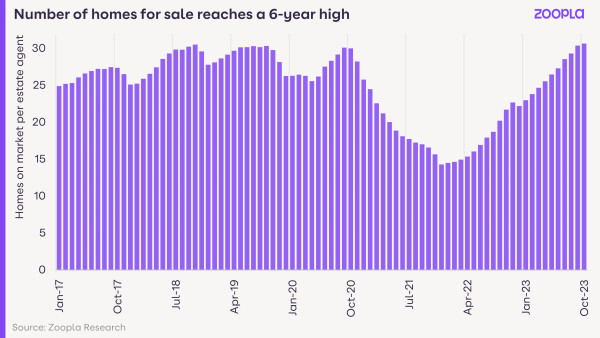
Buyers have room to negotiate on price
During the pandemic years, buyers had to pay the full asking price to secure a property, but not any more.
‘Over the course of 2023, sellers have been accepting ever larger discounts to the asking price to agree a sale,’ says Donnell.
In the first six months of 2023, those discounts averaged out at 3.4% off the asking price.
This month, the average discount recorded is 5.5%, or £18,000. That’s the largest level of discounting seen since 2018.
And buyers in southern England now have the greatest negotiating power of all. It’s where the biggest discounts are going on, with 6.1% reductions on average asking prices.
‘These discounts reflect the fact that sellers haven't been cutting asking prices very quickly,’ says Donnell. ‘As more sellers adjust asking prices lower, we expect these discounts will start to return to normal levels of 3-4%.’
There couldn’t be a better time to buy in London
London has seen slow price growth over the last seven years of just 8%, while for the rest of the UK, house prices have risen 28%.
Homes in the capital are now seen as better value for money, while a steady return to office working is supporting sales volumes and pricing levels here.
In fact, new sales have rebounded more in London than any other part of the UK over the last 2 months, leading to a slight firming in prices.
What’s going to happen to house prices in 2024?
As we edge towards Christmas, the number of homes for sale will start declining as some sellers take their properties off the market with a view to relaunching in the new year.
But it will remain a buyers’ market in 2024, with no rise in house prices anticipated any time soon.
‘The current repricing of homes has further to run in 2024,’ says Donnell.
‘While 5-year fixed mortgage rates have been falling below 5%, they need to fall further to bring more buyers back into the market.’
Key takeaways
- Sellers are accepting an average discount of £18,000 in November 2023
- In London and the South East, that rises to £25,000
- Buyers are now in a strong negotiation position, particularly in southern England

